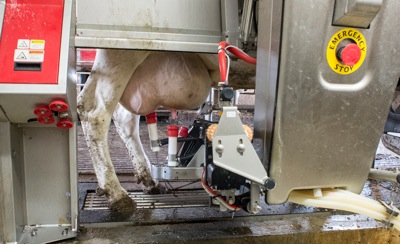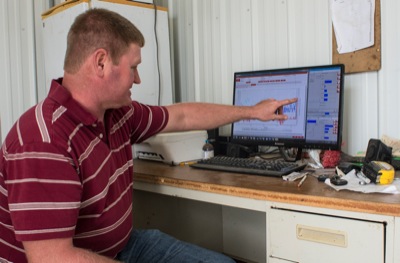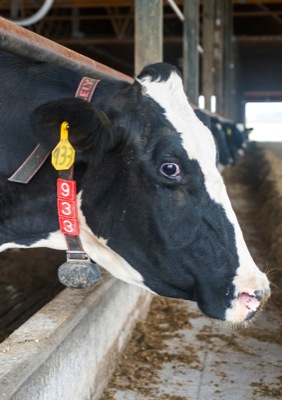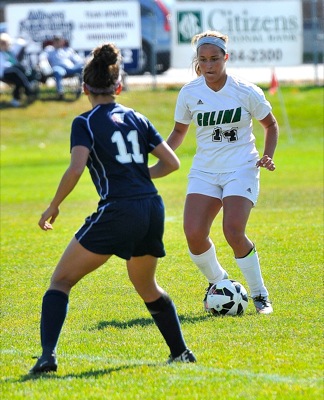Monday, October 12th, 2015
Area dairies using robots to milk cows
Technology frees up farmers' time for family, other work
By Nancy Allen

Photo by Mark Pummell/The Daily Standard
Cups automatically attach to the teets of a cow waiting to be milked at the Dave Schmitmeyer dairy farm near Coldwater.
As reliable labor becomes harder to find and dairy farmers desire a more flexible work schedule, a few have begun using robots to milk their cows.
Another perk of the technology is increased milk production, Coldwater area dairy farmer Dave Schmitmeyer said.
"You get an increase in milk and healthier cows," said Schmitmeyer, 35, who began using robotic milkers about a year ago. "The cows go in whenever they want as often as they want. Some get milked up to six times a day."
Schmitmeyer
uses three robots to milk 150 cows per day at his farm southeast of Coldwater. The switch to robotic milkers helped him expand his herd from 100 cows. Each machine can milk up to 60 animals.
Data from the Ohio Department of Agriculture show 33 dairies in Ohio are using the technology; three are in Mercer County. None are in Auglaize County.
Mercer County has 90 registered dairies and Auglaize County has 56, information from county Farm Service Agency offices shows.
Schmitmeyer said it used to take him two hours to milk his herd and now it takes about 30 minutes. (He still must bring in a few animals called fetch cows each day that don't come into the barn on their own). Before he got the robotic milkers he did the morning milking himself and a high school student did it in the evening.
Schmitmeyer, who is married with three children, said the milkers have freed up his time to do other farm work, spend more time with family and attend social occasions.
"You get so much more flexibility," he said.
When a cow wants to be milked, it steps into a stall, grain is dumped in front of it and brush rollers wash each teat. A laser scans the cow's udder and cups attach to each teat, milking them individually. The machine remembers the location of each individual cow's teat to precisely place the cups.
The technology also collects and stores vital data on each cow - such as how much milk she produces - which farmers can check on their computers. The computer will automatically place a phone call to alert someone if there is a problem with the system.
"It's all computerized," Schmitmeyer said. "Each cow has an ID collar so the computer knows how much she eats, how many times she gets milked, her movement and activity for breeding purposes and other things."
Cows eat less and move around more when they are ready to breed, he explained.
The technology's ability to know when a cow is eating less also can alert dairy operators to potential illness.
"It can detect mastitis and if the mastitis is too bad, it will dump the milk," he said. "It's quite an accomplishment in technology."
Mastitis is the inflammation of the mammary gland and udder tissue usually due to bacteria.
Using robots to milk also makes for happier, less stressed cattle, he said, adding they go to the milkers voluntarily whenever they want.
He said he paid about $180,000 apiece for his particular robotic milkers. They are priced differently based on the options each farmer chooses.
Schmitmeyer's brother, Nick, 31, also uses three robots to milk his 160-head herd and his production is up 15 percent. It used to take him about three and a half hours to milk and feed his cows in the morning and evening. Now it takes about one and a half hours, he said.
Milking no longer dictates his work and social schedule, said the husband and father of three.
"Last weekend we went to Brumbaugh farm over by Greenville around 1:30," Nick Schmitmeyer said during a recent interview. "It used to be you had to be home by 4 p.m. to milk, but we stayed until 6:30 and got home about 7 and all I had to do is go out and get my fetch cows."
The number of dairies using robots to milk cows is growing, said Maurice Eastridge, a dairy specialist with OSU Extension.
"Yes, very much so," he said about the technology expanding in Ohio. "It's picked up in pace compared to what many would have projected. The main reason for that is difficulties in finding a sustainable labor force."
Dairy farmers wanting to spend more time working with their cows versus milking them, and a drop in price on the units, also have spurred their use in the Buckeye state, Eastridge said.
The number of robotic milkers will likely continue to increase, Eastridge said, especially as the next generation of dairy farmers transitions into the industry.
Eastridge said the technology is best suited for small- to medium-sized dairies because it's likely cheaper to hire labor at very large operations than to use robots.
Dave Albers of Prenger's Incorporated, Yorkshire, which sold the technology to the Schmitmeyers, said interest in the milkers is growing. He said another Mercer County dairy on Oct. 5 began using the robotic milkers he sells and he has plans to install them at three or four more farms in the county this year.
Improved quality of life for dairy farmers and increased milk production are the top two reasons producers switch to robots, Albers said. However, the robot's ability to lessen cow stress is invaluable, he said.
"When a cow is in a robot barn, she becomes a different cow. She's in her own world," he said. "You don't have to go out there, push her through and run her through the milking area. She's more relaxed and on her own schedule. Any time an animal is more relaxed and you put less stress on them, she will produce more milk and be a healthier animal."
Robots also are more dependable than humans, he said.
"Getting people to milk on a Sunday morning or Saturday night and getting people to show up on time or at all ... That definitely does draw people," he said. "It's (robotic milker) going to milk that cow no matter what, day or night, rain or shine, Christmas or New Year's."
Nick Schmitmeyer chuckled when asked if he likes the robotic milkers.
"Yeah, I do," he said. "I guess the biggest thing is the freedom to do what you want, when you want. There is really no schedule any more."
Nick and Dave Schmitmeyer's father, Pat Schmitmeyer, agreed.
"These guys get up and eat breakfast with the kids," he said. "I never did that."

Photo by Mark Pummell/The Daily Standard
Dave Schmitmeyer shows different parameters the computer tracks on his robotic milking system.

Photo by Mark Pummell/The Daily Standard
Each cow wears a collar with an ID tag that enables the computer to record individual data on each animal.

